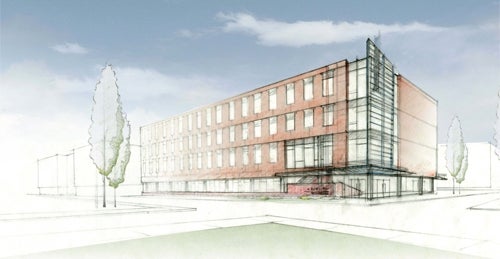Last year, all looked fine and good for Gateway Park in downtown Worcester. Worcester Polytechnic Institute, which is backing the life sciences business park, found a Boston-based developer to construct the next phase of the project.
But the deal with Kavanagh Advisory Group fell through after the company’s letter of intent to proceed with the construction was allowed to expire.
WPI has since bought out the Worcester Business Development Corp.’s stake in the five-building, multi-year development project.
Now the project has new blood, this time in the form of a century-old developer and contractor out of Holyoke named The O’Connell Cos. Inc.
O’Connell, which has its origins in the late 19th century as a construction company, has since expanded into a property development and real estate management firm that has done work throughout New England, and even in Worcester.
Project Details
O’Connell officials have created a limited liability corporation (50 Prescott St. LLC), which the company solely owns, that has plans to rent a parcel from WPI for up to 100 years to construct an estimated $24-million, four-story building on the site. The entire building is expected to house about 140 employees, about 70 of which will be new positions.
Officials at O’Connell said they hope to finalize the lease agreements and financing for the project by year’s end. A formal announcement is expected sometime in early 2011 with a groundbreaking in the spring. Construction should take about 15 to 18 months and doors to the next building in Gateway Park could be opening in the spring of 2012, according to Andrew Crystal, a vice president with O’Connell.
On Dec. 14, the Worcester City Council gave the project its stamp of approval by unanimously adopting a 16-year tax increment financing plan that will save O’Connell $4.43 million during the life of the contract.
It’s hard to pinpoint one specific reason O’Connell seems to have the development on track when other entities were not able to make it work, according to James Umphrey, a principal with Worcester real estate firm Kelleher & Sadowsky Associates Inc., which has been hired by O’Connell to find tenants to occupy the building. There could be numerous factors, they said.
One could simply be O’Connell’s will to get the project done. If the developer of a project really wants to make a project happen, they will put resources behind it and push for it to happen, Umphrey added.
“We’re excited about any new project in this economy,” said Crystal. “We think Worcester is a market that has a lot of potential, and there is already a lot of support throughout the community to see Gateway Park realize the vision that the master plan laid out years ago.”
Crystal said he gets the sense that officials in Worcester are anxious to see the project move forward.
Another reason for O’Connell being able to move forward is the timing. Kavanagh’s proposal was put forth basically in the middle of a recession.
“You’ve got to keep this all in perspective: The first quarter of 2009 was probably about as bad as it could get,” said Will Kelleher, vice president with the commercial real estate firm. “Since then we’ve made some great strides, and it should only go up from here.”
Also, O’Connell owns not only a property management group but a construction firm as well, which means the building of the facility will not need to be contracted out.
The move could potentially signal O’Connell’s desire to tap into the Central Massachusetts markets and even further east, Umphrey suggested.
The development will not be O’Connell’s first project outside of Western Massachusetts, however.
The company led the redevelopment of the former Reed and Prince factory on Cambridge Street in Worcester into a Price Chopper supermarket in the early 2000s.
Earlier this decade, Daniel O’Connell & Sons Inc., the construction portion of the organization, also built Simmons Hall at the Massachusetts Institute of Technology in Cambridge. The firm completed the project in 2002 and has won numerous awards for its unique design and construction.
Gateway Park will not be O’Connell’s first development of laboratory space either.
In 2009 O’Connell completed construction of a 70,000-square-foot science and computation complex at Bard College, a small liberal arts school in upstate New York. The building serves the college’s biological, chemistry and computational programs, as well as having space for general classroom use.
“It came in pretty much on time and on budget, there’s something to be said for that,” noted Mark Halsey, an associate dean with the school.
By many accounts O’Connell has a solid reputation. In the company’s hometown of Holyoke, economic development director Kathy Anderson said O’Connell has been a model corporate citizen. In addition to constructing, owning and managing a business office complex in the city, officials with the company have also aided the city in creating and implementing new zoning regulations and in developing a master plan.
Perhaps those that will be most directly impacted by the new development are some of the tenants in the current Gateway Park building 1, the 120,000-square foot WPI Life Sciences and Bioengineering Center. The building was completed in 2007 and now houses RXi Pharmaceuticals Corp., Blue Sky Biotech Inc. and CellThera.
The TIF that was approved by the city council will allow O’Connell to offer reduced rental rates to the tenants, making them competitive with the rest of the market.
The TIF is expected to be a 47 percent average break on taxes during the 16-year lifespan of the contract. During that time the city will still collect almost $5.2 million in taxes. Beginning in 2027, when the full amount of taxes will be paid, the city expects to collect about $600,000 annually in new taxes from the property.
About half of the building’s space is already leased.

